I've sent off to Ran an updated In My Opinion article on the history of golf at Penn State which catalogs some of my significant finds over the past five years since the original posting. I think he's in the process of posting it, but I figured I'd start a thread in advance.
Golf at Penn State is almost an afterthought. The golf season and school year for the most part do not overlap; with snow cover being possible anytime between November and April, most of the students get two or three months at most with which to play golf. It would probably come as no surprise to not find any worthwhile golf experience in State College, PA, however, the Penn State Golf Courses are filled with relevance spreading across over ninety years of golf architecture history.
To date, the earliest known record of golf at Penn State comes from a December 1, 1901 article in the student-run organ Free Lance. Of note is the mention in the article that Penn State students and faculty played golf around the campus for several years at the time and that the intramural club recently completed laying out nine holes complete with new hole tins. Superintendents may delight to read that the article also laments the swiping of the red flags used to mark the holes by students as pranks.
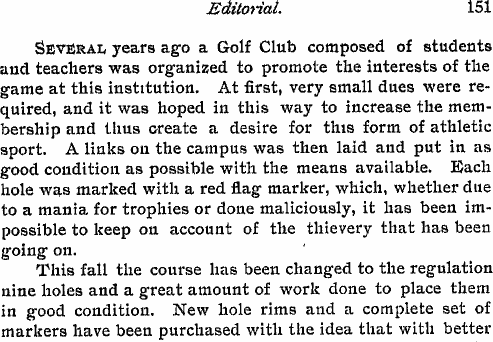 December 1, 1901 Free Lance Article
December 1, 1901 Free Lance ArticleResearch has yielded little about this early layout so far. However, a December 10, 1908 article in the Daily Collegian (which supplanted the Free Lance as the College’s student newspaper in 1904) reported the golf course lasted four to five years before being seized for College expansion and the student body had been lobbying for a reinstatement of the golf course ever since.
In January 1919, the College dedicated itself to a comprehensive athletic plant and program with athletic facilities including a new nine hole golf course on the western edge of campus situated near a new gymnasium (Recreation Hall) and football stadium. Contemporary Daily Collegian articles credit athletic director Hugo Bezdek, who also managed the Pittsburgh Pirates at the time, with the vision for the entire athletic program. Bezdek hired New England-based R. D. Pryde to lay out the nine hole golf course. The Daily Collegian reports that Pryde completed five of the holes within the year and soon completed the remaining four holes in 1920. At this time, Bezdek hired New Britain Country Club (Connecticut) golf professional Robert D. “Pop” Rutherford to supervise the sport’s development and growth at Penn State.
Rutherford organized the golf teams and began competition with local Country Clubs and other Universities. Rutherford also served as golf professional and greenkeeper. Popularity in the sport grew under Rutherford’s leadership and by 1922, the golf facilities at Penn State underwent their most significant upgrade and expansion to date under none other than Scottish golf professional and architect Willie Park, Jr.
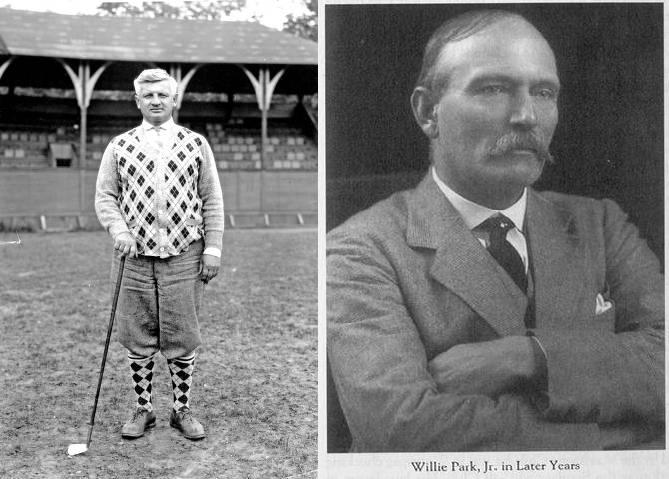 Hugo Bezdek and Willie Park, Jr. (Courtesy of Penn State Digital Photo Archives and John Adams, The Parks of Musselburgh)Willie Park, Jr. at Penn State
Hugo Bezdek and Willie Park, Jr. (Courtesy of Penn State Digital Photo Archives and John Adams, The Parks of Musselburgh)Willie Park, Jr. at Penn StateDaily Collegian reported that Willie Park, Jr. spent six days on-site in State College during the Fall of 1922. Park’s plans upgraded the current nine holes and added a second nine. Daily Collegian noted that Park “gave special attention to the nittany course” and that this project was the “first college operation he had designed.” Park’s work would include all new bunkers and greens while using the original fairway corridors. The University is currently in possession of a copy of the full 18 hole routing, complete with distances as drawn by Willie Park, and this can be found displayed prominently in the front of the Penn State Golf Courses Clubhouse.
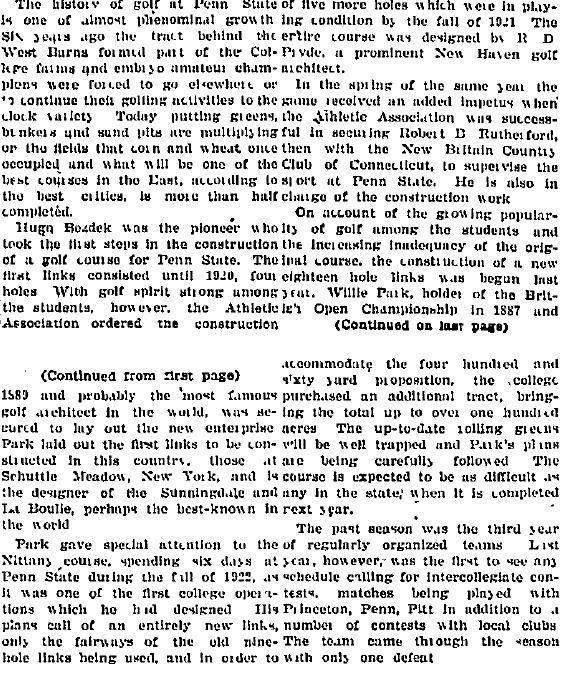 July 22, 1924 Daily Collegian – An Account of the Creation of the Penn State Golf Course
July 22, 1924 Daily Collegian – An Account of the Creation of the Penn State Golf CourseThis article also reports that the College acquired land further west of the original course to accommodate a newly designed 460 yard hole. Further details from contemporary Daily Collegian articles note that Park’s finished lay out extended to over 6400 yards and that play on the original nine holes would not be interrupted while construction of the new nine commenced. A notable line from this article states that the course would be “of official championship length and without a doubt the best course maintained by any college in the country,” showing that even in 1922, new development in golf stood prone to sometimes bold claims.
Willie Park historians may note this time frame as the beginning of the intrepid architect’s slow decline into poor health. The trip to remote State College, PA required an over five hour train ride from New York City or four hour train ride from Philadelphia to Altoona, PA along the Pennsylvania Railroad mainline and then another hour long trip by train into State College. When placed in the context of Park’s other contemporaneous projects at Philmont Country Club, Ashbourne Country Club and Green Valley Country Club in the Philadelphia area it is easy to see how Park’s health was at risk due to over work.
Work on the golf course commenced in October 1922 under the direction of “Pop” Rutherford as superintendent. To date, it is uncertain as to the reason why golf course construction lasted into 1924 where a Daily Collegian bulletin announced temporary greens would be open on the newly constructed holes but warned that play would not be permitted on the new putting surfaces until the seed had established. The Daily Collegian also proudly announced that a freshman golfer had established the course record of 67 in May 1928.
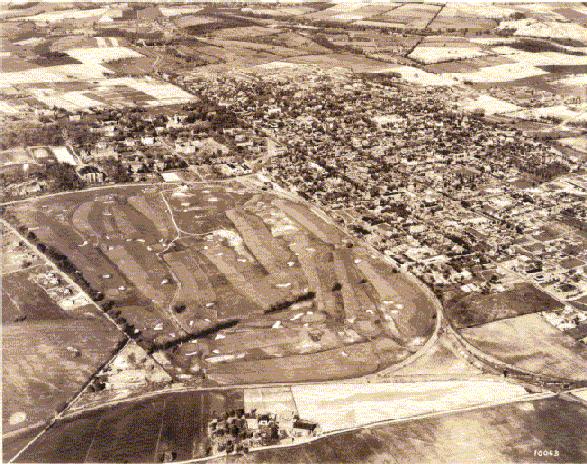 The Golf Course in 1928 – Fourth Hole in Foreground (Courtesy: Hagley Museum and Library, Dallin Collection)
The Golf Course in 1928 – Fourth Hole in Foreground (Courtesy: Hagley Museum and Library, Dallin Collection)The golf course remained unchanged with the exception of the relocation of one green due to the construction of a new railroad freight facility in 1940. This change is seen in comparing the aerial photograph from 1938 and 1971. The original hole was likely a typical Willie Park short hole, similar to the type found at Glen Ridge Country Club’s second hole or Schuylkill Country Club’s sixteenth hole. Also of interest is the addition of another short hole near the 1st green. This hole is not seen in the Willie Park routing but is present in diagrams of the course as early as 1938. Perhaps the hole was designed to facilitate two tee starts or the reversal of the nines (the original first tee was located very near the right-of-way for Atherton Street – present day U.S. Business Route 322) but the actual origin and purpose for the hole is not known as of this writing.
 The Second Green (Thirteenth Today) – 1928 (Photo Courtesy: La Vie 1928)The University Era
The Second Green (Thirteenth Today) – 1928 (Photo Courtesy: La Vie 1928)The University EraPenn State’s remarkable growth following World War II under the direction of Milton Eisenhower granted the College University status by 1953 This growth coincided with a rejuvenation of the athletic program following the reinstatement of athletic scholarships in the 1940s (Notably, football assistant coach Joe Paterno joined the staff with head coach Rip Engle in 1950). Demand for golf increased to the point that the University began considering a second eighteen hole course in the late 1950s and this finally came to approval in 1964, as reported in The Daily Collegian.
The firm of Ferdinand Garbin and James Harrison designed the new “Blue” Course to complement Willie Park’s “White” Course. The Blue Course opened in 1969 on property adjacent to the White Course and played just over 7000 yards. A new clubhouse and practice facility was constructed along a driveway connecting to West College Avenue a mile from the campus to accommodate the new course while the White Course continued to operate out of the Pro Shop located behind Recreation Hall.
The Blue Course OpensHarrison & Garbin were both golf architects of the Donald Ross lineage and both were Penn State alumni whose work focused primarily in Western Pennsylvania, making them ideal candidates for the new course. The course played across more rugged and wooded terrain than the White Course and the routing did much to take advantage of these features. Reflecting the style at the time, the greens were bigger and generally flatter with sparse but effective bunker placement.
Notable holes on the layout included the long second and third holes of 540 and 460 yards respectively playing over the most severe portion of the property and requiring the golfer to maneuver across reverse camber doglegs. The stretch of holes starting at the twelfth through the finish challenges the golfer’s distance ability and decision making. The twelfth tee shot forced a particularly vexing decision. Players teed off to a fairway bending to the right and down into a stand of woods. The player could play to the top of the hill leaving an approach no shorter than 180 yards to a well bunkered green placed across the valley. The second option compelled the player to flirt with the right edge of the tree line and allow the ball to bound to the bottom of the valley leaving a short pitch to the green above. Shots played too far and left would be kicked into the trees left while shots not reaching the ridge right would be slightly blocked by the overhanging limbs from the trees right.
Perhaps the only true criticism of the layout is found in the lack of short hole variety as the quartet all played within the 170-200 yard range. However, it is important to note that the routing allowed for all four to play in different directions, as well as featuring a downhill, uphill and two oppositely sidehill holes.
Consolidation and Modernization: 1994-2010The golf courses remained largely unchanged through the next two decades. By the early 1990s, the University began an era of unparalleled expansion linked to joining the Big Ten and a desire for a larger academic plant. The available land forced new construction across Atherton Street into the traditional athletic fields, including the golf course. With land available along the entrance drive for the Blue Course, plans were made to begin running a 36 hole facility from this location while yielding land from the White Course for new academic buildings. The golf architecture firm of Ault, Clark and Associates were retained to sort through the planning and implementation of linking both courses to run from the West College Avenue location.
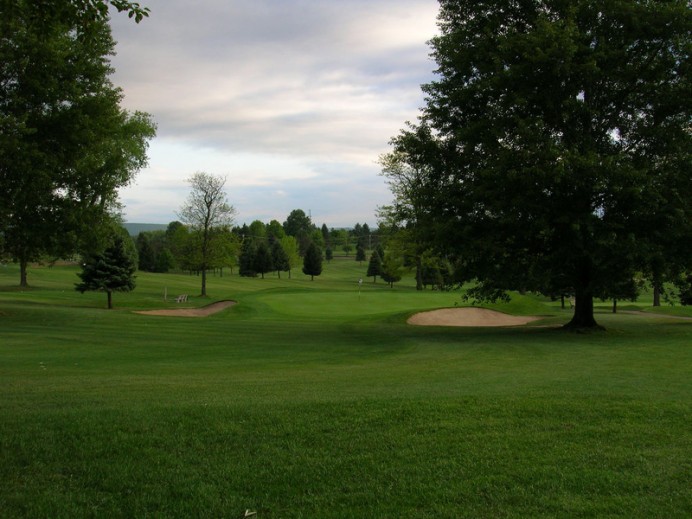 Penn State White Course 2005 – Ninth Hole (Photo by Author)
Penn State White Course 2005 – Ninth Hole (Photo by Author)The initial plan implemented gave over the tenth and eighteenth holes of the White Course to the displaced Rugby and Soccer fields, retained much of the first nine of the Blue Course to serve as the beginning and finishing holes for the White Course (thus linking the Willie Park holes to the new clubhouse), set aside six holes from the White Course as a practice course and finally, constructed a completely new second nine for the Blue Course on the property just south of the older nine along with two new holes for the White Course to make up for the lost tenth and eighteenth. The second nine for the Blue became the first nine.
Oddly, this arrangement gives both courses several different stylistic approaches contained wholly within a single round. The two distinct nines of the Blue Course are good examples of their respective architectural eras, while the White Course—with the middle stretch containing the Willie Park holes—has a museum-like quality showcasing different eras in different contexts of the round.
 Penn State Blue Course 2005 – Fourteenth Hole (Photo by Author)
Penn State Blue Course 2005 – Fourteenth Hole (Photo by Author)Again, in 2003, the golf courses initiated a master plan. The goal was to host the Big Ten Championship on the Blue Course and upgrade the White Course with a nod to its lineage. David Heatwole, a former Jack Nicklaus associate and current, independent golf architect in State College, PA, reworked the seventh and eighth holes into a more appropriate test of golfing mettle. While the seventh hole stood as a fine one-shotter, a heightening tree line and increased technology victimized the awkward ninety-degree-dogleg eighth. Heatwole relocated the seventh green into the landing zone of the eighth, creating a 440 yard proposition that required—perhaps on purpose, considering the lineage—two high faded shots to achieve the hole in regulation. The new eighth tee replicates the original uphill approach shot of the old eighth hole. This latest change further adds to the architectural diversity of the Penn State facility.
The 2003 master plan also ushered in an era of White Course revitalization that stretched the course to over 6300 yards by rebuilding and relocating several tees. Further tree removal, fairway and green expansion further restored the remaining 1922 holes as intended by Willie Park and this work continues to this day under the careful eye of Superintendent Rick Pagett.
The Penn State Golf Courses offer thirty-six holes of worthy architectural study. When coupled with exploring nearby Toftrees Resort, Alex Findlay’s Centre Hills Country Club and the State College Elks, State College is a unique golf destination that provides a suitable golf experience for all golfers.